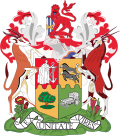| Province of Natal | |||||||||
|---|---|---|---|---|---|---|---|---|---|
| Province of South Africa | |||||||||
| 1910–1994 | |||||||||
 Natal as it was by 1994 | |||||||||
| Capital | Pietermaritzburg | ||||||||
| Demonym | Natalian | ||||||||
| Area | |||||||||
| • Coordinates | 29°S30°E / 29°S 30°E | ||||||||
| Population | |||||||||
• 1991 | 2,430,753 [1] | ||||||||
| Legislature | Natal Provincial Council | ||||||||
| History | |||||||||
• Established | 31 May 1910 | ||||||||
• Disestablished | 27 April 1994 | ||||||||
| |||||||||
The Province of Natal (Afrikaans : Natalprovinsie), commonly called Natal, was a province of South Africa from May 1910 until May 1994. Its capital was Pietermaritzburg. During this period rural areas inhabited by the black African population of Natal were organised into the Bantustan of KwaZulu, which was progressively separated from the province, becoming partially autonomous in 1981. For the significant population of Indian South Africans residing in Natal, the third-largest city of Durban was organised for them. Of the white population mostly in the largest city of Johannesburg, the majority were English-speaking people of British descent, causing Natal to become the only province to vote "No" to the creation of a republic in the referendum of 1960, due to very strong monarchist, pro-British Commonwealth, and anti-secessionist sentiment. [2] In the latter part of the 1980s, Natal was in a state of violence between the Inkatha Freedom Party and the African National Congress, with violence subsiding soon after the first non-racial election in 1994. [3] [4]
Contents
In 1994, the KwaZulu Bantustan was reincorporated into the territory of Natal and the province was redesignated as KwaZulu-Natal.


